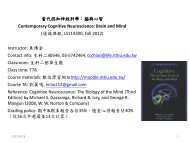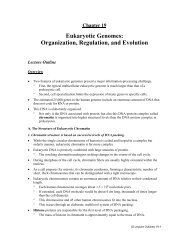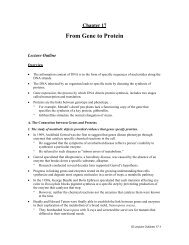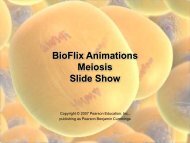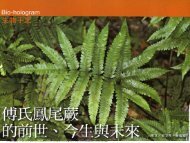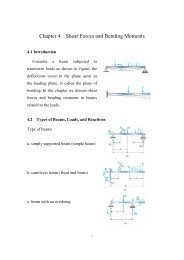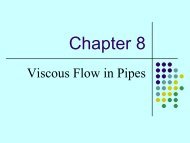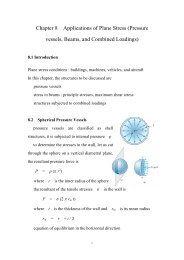Response
Response
Response
You also want an ePaper? Increase the reach of your titles
YUMPU automatically turns print PDFs into web optimized ePapers that Google loves.
Chapter 39Plant <strong>Response</strong>s to Internaland External SignalsPowerPoint ® Lecture Presentations forBiologyEighth EditionNeil Campbell and Jane ReeceLectures by Chris Romero, updated by Erin Barley with contributions from Joan SharpCopyright © 2008 Pearson Education, Inc., publishing as Pearson Benjamin Cummings
Overview: Stimuli and a Stationary Life• Linnaeus noted that flowers of different speciesopened at different times of day and could beused as a horologium florae, or floral clock• Plants, being rooted to the ground, mustrespond to environmental changes that cometheir way• For example, the bending of a seedling towardlight begins with sensing the direction, quantity,and color of the lightCopyright © 2008 Pearson Education, Inc., publishing as Pearson Benjamin Cummings
Fig. 39-1
Concept 39.1: Signal transduction pathways linksignal reception to response• Plants have cellular receptors that detectchanges in their environment• For a stimulus to elicit a response, certain cellsmust have an appropriate receptor• Stimulation of the receptor initiates a specificsignal transduction pathwayCopyright © 2008 Pearson Education, Inc., publishing as Pearson Benjamin Cummings
• A potato left growing in darkness producesshoots that look unhealthy and lacks elongatedroots• These are morphological adaptations forgrowing in darkness, collectively calledetiolation• After exposure to light, a potato undergoeschanges called de-etiolation, in which shootsand roots grow normallyCopyright © 2008 Pearson Education, Inc., publishing as Pearson Benjamin Cummings
Fig. 39-2(a) Before exposure to light(b) After a week’s exposure tonatural daylight
• A potato’s response to light is an example ofcell-signal processing• The stages are reception, transduction, andresponseCopyright © 2008 Pearson Education, Inc., publishing as Pearson Benjamin Cummings
Fig. 39-3CELLWALLCYTOPLASM1 Reception 2 Transduction 3 <strong>Response</strong>Relay proteins andsecond messengersActivationof cellularresponsesReceptorHormone orenvironmentalstimulusPlasma membrane
Reception• Internal and external signals are detected byreceptors, proteins that change in response tospecific stimuliCopyright © 2008 Pearson Education, Inc., publishing as Pearson Benjamin Cummings
Transduction• Second messengers transfer and amplifysignals from receptors to proteins that causeresponsesCopyright © 2008 Pearson Education, Inc., publishing as Pearson Benjamin Cummings
Fig. 39-4-1Reception1 2TransductionCellwallPlasmamembraneCYTOPLASMPhytochromeactivatedby lightcGMPSecond messengerproducedSpecificproteinkinase 1activatedNUCLEUSLight
Fig. 39-4-2Reception1 2TransductionCellwallPlasmamembraneCYTOPLASMPhytochromeactivatedby lightcGMPSecond messengerproducedSpecificproteinkinase 1activatedSpecificproteinkinase 2activatedNUCLEUSLightCa 2+ channelopenedCa 2+
Fig. 39-4-3CellwallReception1 2LightPlasmamembraneCYTOPLASMPhytochromeactivatedby lightcGMPTransductionSecond messengerproducedSpecificproteinkinase 1activatedSpecificproteinkinase 2activated3Transcriptionfactor 1Transcriptionfactor 2<strong>Response</strong>PNUCLEUSPTranscriptionTranslationCa 2+ channelopenedDe-etiolation(greening)responseproteinsCa 2+
<strong>Response</strong>• A signal transduction pathway leads toregulation of one or more cellular activities• In most cases, these responses to stimulationinvolve increased activity of enzymes• This can occur by transcriptional regulation orpost-translational modificationCopyright © 2008 Pearson Education, Inc., publishing as Pearson Benjamin Cummings
Transcriptional Regulation• Specific transcription factors bind directly tospecific regions of DNA and controltranscription of genes• Positive transcription factors are proteins thatincrease the transcription of specific genes,while negative transcription factors are proteinsthat decrease the transcription of specificgenesCopyright © 2008 Pearson Education, Inc., publishing as Pearson Benjamin Cummings
Post-Translational Modification of Proteins• Post-translational modification involvesmodification of existing proteins in the signalresponse• Modification often involves the phosphorylationof specific amino acidsCopyright © 2008 Pearson Education, Inc., publishing as Pearson Benjamin Cummings
De-Etiolation (“Greening”) Proteins• Many enzymes that function in certain signalresponses are directly involved inphotosynthesis• Other enzymes are involved in supplyingchemical precursors for chlorophyll productionCopyright © 2008 Pearson Education, Inc., publishing as Pearson Benjamin Cummings
Concept 39.2: Plant hormones help coordinategrowth, development, and responses to stimuli• Hormones are chemical signals thatcoordinate different parts of an organismCopyright © 2008 Pearson Education, Inc., publishing as Pearson Benjamin Cummings
The Discovery of Plant Hormones• Any response resulting in curvature of organstoward or away from a stimulus is called atropism• Tropisms are often caused by hormonesCopyright © 2008 Pearson Education, Inc., publishing as Pearson Benjamin Cummings
• In the late 1800s, Charles Darwin and his sonFrancis conducted experiments onphototropism, a plant’s response to light• They observed that a grass seedling couldbend toward light only if the tip of the coleoptilewas present• They postulated that a signal was transmittedfrom the tip to the elongating regionVideo: PhototropismPCopyright © 2008 Pearson Education, Inc., publishing as Pearson Benjamin Cummings
Fig. 39-5RESULTSControlLightShadedside ofcoleoptileIlluminatedside ofcoleoptileDarwin and Darwin: phototropic responseonly when tip is illuminatedLightTipremovedTip coveredby opaquecapTipcoveredby transparentcapSite ofcurvaturecovered byopaqueshieldBoysen-Jensen: phototropic response when tip separatedby permeable barrier, but not with impermeable barrierLightTip separatedby gelatin(permeable)Tip separatedby mica(impermeable)
Fig. 39-5aRESULTSControlLightShadedside ofcoleoptileIlluminatedside ofcoleoptile
Fig. 39-5bRESULTSDarwin and Darwin: phototropic responseonly when tip is illuminatedLightTipremovedTip coveredby opaquecapTipcoveredby transparentcapSite ofcurvaturecovered byopaqueshield
• In 1913, Peter Boysen-Jensen demonstratedthat the signal was a mobile chemicalsubstanceCopyright © 2008 Pearson Education, Inc., publishing as Pearson Benjamin Cummings
Fig. 39-5cRESULTSBoysen-Jensen: phototropic response when tip is separatedby permeable barrier, but not with impermeable barrierLightTip separatedby gelatin(permeable)Tip separatedby mica(impermeable)
• In 1926, Frits Went extracted the chemicalmessenger for phototropism, auxin, bymodifying earlier experimentsCopyright © 2008 Pearson Education, Inc., publishing as Pearson Benjamin Cummings
Fig. 39-6RESULTSExcised tip placedon agar cubeGrowth-promotingchemical diffusesinto agar cubeControlControl(agar cubelackingchemical)has noeffectAgar cubewith chemicalstimulates growthOffset cubescause curvature
A Survey of Plant Hormones• In general, hormones control plant growth anddevelopment by affecting the division,elongation, and differentiation of cells• Plant hormones are produced in very lowconcentration, but a minute amount can greatlyaffect growth and development of a plant organCopyright © 2008 Pearson Education, Inc., publishing as Pearson Benjamin Cummings
Table 39-1
Auxin• The term auxin refers to any chemical thatpromotes elongation of coleoptiles• Indoleacetic acid (IAA) is a common auxin inplants; in this lecture the term auxin refersspecifically to IAA• Auxin transporter proteins move the hormonefrom the basal end of one cell into the apicalend of the neighboring cellCopyright © 2008 Pearson Education, Inc., publishing as Pearson Benjamin Cummings
Fig. 39-7RESULTSCell 1100 µmCell 2EpidermisCortexPhloemXylemPithBasal endof cell25 µm
The Role of Auxin in Cell Elongation• According to the acid growth hypothesis, auxinstimulates proton pumps in the plasmamembrane• The proton pumps lower the pH in the cell wall,activating expansins, enzymes that loosen thewall’s fabric• With the cellulose loosened, the cell canelongateCopyright © 2008 Pearson Education, Inc., publishing as Pearson Benjamin Cummings
Fig. 39-8Cross-linkingpolysaccharidesCell wall–looseningenzymes3 Expansins separatemicrofibrils from crosslinkingpolysaccharides.ExpansinCellulosemicrofibrilCELL WALL4 Cleaving allowsmicrofibrils to slide.H 2O2 Cell wallbecomesmore acidic.PlasmamembraneCellwall1 Auxinincreasesproton pumpactivity.Plasma membraneCYTOPLASMNucleus CytoplasmVacuole5 Cell can elongate.
Lateral and Adventitious Root Formation• Auxin is involved in root formation andbranchingCopyright © 2008 Pearson Education, Inc., publishing as Pearson Benjamin Cummings
Auxins as Herbicides• An overdose of synthetic auxins can killeudicotsCopyright © 2008 Pearson Education, Inc., publishing as Pearson Benjamin Cummings
Other Effects of Auxin• Auxin affects secondary growth by inducing celldivision in the vascular cambium andinfluencing differentiation of secondary xylemCopyright © 2008 Pearson Education, Inc., publishing as Pearson Benjamin Cummings
Cytokinins• Cytokinins are so named because theystimulate cytokinesis (cell division)Copyright © 2008 Pearson Education, Inc., publishing as Pearson Benjamin Cummings
Control of Cell Division and Differentiation• Cytokinins are produced in actively growingtissues such as roots, embryos, and fruits• Cytokinins work together with auxin to controlcell division and differentiationCopyright © 2008 Pearson Education, Inc., publishing as Pearson Benjamin Cummings
Control of Apical Dominance• Cytokinins, auxin, and other factors interact inthe control of apical dominance, a terminalbud’s ability to suppress development ofaxillary buds• If the terminal bud is removed, plants becomebushierCopyright © 2008 Pearson Education, Inc., publishing as Pearson Benjamin Cummings
Fig. 39-9Lateral branches“Stump” afterremoval ofapical bud(b) Apical bud removedAxillary buds(a) Apical bud intact (not shown in photo)(c) Auxin added to decapitated stem
Anti-Aging Effects• Cytokinins retard the aging of some plantorgans by inhibiting protein breakdown,stimulating RNA and protein synthesis, andmobilizing nutrients from surrounding tissuesCopyright © 2008 Pearson Education, Inc., publishing as Pearson Benjamin Cummings
Gibberellins• Gibberellins have a variety of effects, such asstem elongation, fruit growth, and seedgerminationCopyright © 2008 Pearson Education, Inc., publishing as Pearson Benjamin Cummings
Stem Elongation• Gibberellins stimulate growth of leaves andstems• In stems, they stimulate cell elongation and celldivisionCopyright © 2008 Pearson Education, Inc., publishing as Pearson Benjamin Cummings
Fruit Growth• In many plants, both auxin and gibberellinsmust be present for fruit to set• Gibberellins are used in spraying of Thompsonseedless grapesCopyright © 2008 Pearson Education, Inc., publishing as Pearson Benjamin Cummings
Fig. 39-10(b) Gibberellin-induced fruitgrowth(a) Gibberellin-induced stemgrowth
Germination• After water is imbibed, release of gibberellinsfrom the embryo signals seeds to germinateCopyright © 2008 Pearson Education, Inc., publishing as Pearson Benjamin Cummings
Fig. 39-111 Gibberellins (GA)send signal toaleurone.2 Aleurone secretes3 Sugars and otherα-amylase and other enzymes. nutrients are consumed.AleuroneEndospermGAα-amylaseSugarWaterGAScutellum(cotyledon)Radicle
Brassinosteroids• Brassinosteroids are chemically similar to thesex hormones of animals• They induce cell elongation and division instem segmentsCopyright © 2008 Pearson Education, Inc., publishing as Pearson Benjamin Cummings
Abscisic Acid• Abscisic acid (ABA) slows growth• Two of the many effects of ABA:– Seed dormancy– Drought toleranceCopyright © 2008 Pearson Education, Inc., publishing as Pearson Benjamin Cummings
Seed Dormancy• Seed dormancy ensures that the seed willgerminate only in optimal conditions• In some seeds, dormancy is broken when ABAis removed by heavy rain, light, or prolongedcold• Precocious germination is observed in maizemutants that lack a transcription factor requiredfor ABA to induce expression of certain genesCopyright © 2008 Pearson Education, Inc., publishing as Pearson Benjamin Cummings
Fig. 39-12Early germinationin red mangroveColeoptileEarly germinationin maize mutant
Drought Tolerance• ABA is the primary internal signal that enablesplants to withstand droughtCopyright © 2008 Pearson Education, Inc., publishing as Pearson Benjamin Cummings
Ethylene• Plants produce ethylene in response tostresses such as drought, flooding, mechanicalpressure, injury, and infection• The effects of ethylene include response tomechanical stress, senescence, leaf abscission,and fruit ripeningCopyright © 2008 Pearson Education, Inc., publishing as Pearson Benjamin Cummings
The Triple <strong>Response</strong> to Mechanical Stress• Ethylene induces the triple response, whichallows a growing shoot to avoid obstacles• The triple response consists of a slowing ofstem elongation, a thickening of the stem, andhorizontal growthCopyright © 2008 Pearson Education, Inc., publishing as Pearson Benjamin Cummings
Fig. 39-130.00 0.10 0.20 0.40 0.80Ethylene concentration (parts per million)
• Ethylene-insensitive mutants fail to undergo thetriple response after exposure to ethylene• Other mutants undergo the triple response inair but do not respond to inhibitors of ethylenesynthesisCopyright © 2008 Pearson Education, Inc., publishing as Pearson Benjamin Cummings
Fig. 39-14ein mutantctr mutant(a) ein mutant(b) ctr mutant
Senescence• Senescence is the programmed death of plantcells or organs• A burst of ethylene is associated withapoptosis, the programmed destruction ofcells, organs, or whole plantsCopyright © 2008 Pearson Education, Inc., publishing as Pearson Benjamin Cummings
Leaf Abscission• A change in the balance of auxin and ethylenecontrols leaf abscission, the process thatoccurs in autumn when a leaf fallsCopyright © 2008 Pearson Education, Inc., publishing as Pearson Benjamin Cummings
Fig. 39-150.5 mmProtective layerStemAbscission layerPetiole
Fruit Ripening• A burst of ethylene production in a fruit triggersthe ripening processCopyright © 2008 Pearson Education, Inc., publishing as Pearson Benjamin Cummings
Systems Biology and Hormone Interactions• Interactions between hormones and signaltransduction pathways make it hard to predicthow genetic manipulation will affect a plant• Systems biology seeks a comprehensiveunderstanding that permits modeling of plantfunctionsCopyright © 2008 Pearson Education, Inc., publishing as Pearson Benjamin Cummings
Concept 39.3: <strong>Response</strong>s to light are critical forplant success• Light cues many key events in plant growthand development• Effects of light on plant morphology are calledphotomorphogenesisCopyright © 2008 Pearson Education, Inc., publishing as Pearson Benjamin Cummings
• Plants detect not only presence of light but alsoits direction, intensity, and wavelength (color)• A graph called an action spectrum depictsrelative response of a process to differentwavelengths• Action spectra are useful in studying anyprocess that depends on lightCopyright © 2008 Pearson Education, Inc., publishing as Pearson Benjamin Cummings
Fig. 39-161.0436 nmPhototropic effectiveness0.80.60.40.20400 450 500 550 600 650 700Wavelength (nm)(a) Action spectrum for blue-light phototropismLightTime = 0 minTime = 90 min(b) Coleoptile response to light colors
Fig. 39-16a1.0436 nmPhototropic effectiveness0.80.60.40.20400 450 500 550 600 650 700Wavelength (nm)(a) Action spectrum for blue-light phototropism
Fig. 39-16bLightTime = 0 minTime = 90 min(b) Coleoptile response to light colors
• There are two major classes of light receptors:blue-light photoreceptors andphytochromesCopyright © 2008 Pearson Education, Inc., publishing as Pearson Benjamin Cummings
Blue-Light Photoreceptors• Various blue-light photoreceptors controlhypocotyl elongation, stomatal opening, andphototropismCopyright © 2008 Pearson Education, Inc., publishing as Pearson Benjamin Cummings
Phytochromes as Photoreceptors• Phytochromes are pigments that regulate manyof a plant’s responses to light throughout its life• These responses include seed germination andshade avoidanceCopyright © 2008 Pearson Education, Inc., publishing as Pearson Benjamin Cummings
Phytochromes and Seed Germination• Many seeds remain dormant until lightconditions change• In the 1930s, scientists at the U.S. Departmentof Agriculture determined the action spectrumfor light-induced germination of lettuce seedsCopyright © 2008 Pearson Education, Inc., publishing as Pearson Benjamin Cummings
Fig. 39-17RESULTSDark (control)RedDarkRed Far-red DarkRed Far-red Red Dark Red Far-red Red Far-red
• Red light increased germination, while far-redlight inhibited germination• The photoreceptor responsible for the opposingeffects of red and far-red light is a phytochromeCopyright © 2008 Pearson Education, Inc., publishing as Pearson Benjamin Cummings
Fig. 39-18Two identical subunitsChromophorePhotoreceptor activityKinase activity
Fig. 39-UN1Red lightP rP frFar-red light
• Phytochromes exist in two photoreversiblestates, with conversion of P r to P fr triggeringmany developmental responsesCopyright © 2008 Pearson Education, Inc., publishing as Pearson Benjamin Cummings
Fig. 39-19SynthesisP rRed lightP fr<strong>Response</strong>s:seed germination,control offlowering, etc.Far-redlightSlow conversionin darkness(some plants)Enzymaticdestruction
Phytochromes and Shade Avoidance• The phytochrome system also provides theplant with information about the quality of light• Shaded plants receive more far-red than redlight• In the “shade avoidance” response, thephytochrome ratio shifts in favor of P r when atree is shadedCopyright © 2008 Pearson Education, Inc., publishing as Pearson Benjamin Cummings
Biological Clocks and Circadian Rhythms• Many plant processes oscillate during the day• Many legumes lower their leaves in theevening and raise them in the morning, evenwhen kept under constant light or darkconditionsCopyright © 2008 Pearson Education, Inc., publishing as Pearson Benjamin Cummings
Fig. 39-20NoonMidnight
• Circadian rhythms are cycles that are about24 hours long and are governed by an internal“clock”• Circadian rhythms can be entrained to exactly24 hours by the day/night cycle• The clock may depend on synthesis of aprotein regulated through feedback control andmay be common to all eukaryotesCopyright © 2008 Pearson Education, Inc., publishing as Pearson Benjamin Cummings
The Effect of Light on the Biological Clock• Phytochrome conversion marks sunrise andsunset, providing the biological clock withenvironmental cuesCopyright © 2008 Pearson Education, Inc., publishing as Pearson Benjamin Cummings
Photoperiodism and <strong>Response</strong>s to Seasons• Photoperiod, the relative lengths of night andday, is the environmental stimulus plants usemost often to detect the time of year• Photoperiodism is a physiological response tophotoperiodCopyright © 2008 Pearson Education, Inc., publishing as Pearson Benjamin Cummings
Photoperiodism and Control of Flowering• Some processes, including flowering in manyspecies, require a certain photoperiod• Plants that flower when a light period is shorterthan a critical length are called short-dayplants• Plants that flower when a light period is longerthan a certain number of hours are called longdayplants• Flowering in day-neutral plants is controlledby plant maturity, not photoperiodCopyright © 2008 Pearson Education, Inc., publishing as Pearson Benjamin Cummings
Critical Night Length• In the 1940s, researchers discovered thatflowering and other responses to photoperiodare actually controlled by night length, not daylengthCopyright © 2008 Pearson Education, Inc., publishing as Pearson Benjamin Cummings
• Short-day plants are governed by whether thecritical night length sets a minimum number ofhours of darkness• Long-day plants are governed by whether thecritical night length sets a maximum number ofhours of darknessCopyright © 2008 Pearson Education, Inc., publishing as Pearson Benjamin Cummings
Fig. 39-2124 hours(a) Short-day (long-night)plantLightCriticaldark periodFlashoflightDarkness(b) Long-day (short-night)plantFlashoflight
• Red light can interrupt the nighttime portion ofthe photoperiod• Action spectra and photoreversibilityexperiments show that phytochrome is thepigment that receives red lightCopyright © 2008 Pearson Education, Inc., publishing as Pearson Benjamin Cummings
Fig. 39-2224 hoursRRFRRFRRRFRRFRCritical dark periodShort-day(long-night)plantLong-day(short-night)plant
• Some plants flower after only a single exposureto the required photoperiod• Other plants need several successive days ofthe required photoperiod• Still others need an environmental stimulus inaddition to the required photoperiod– For example, vernalization is a pretreatmentwith cold to induce floweringCopyright © 2008 Pearson Education, Inc., publishing as Pearson Benjamin Cummings
A Flowering Hormone?• The flowering signal, not yet chemicallyidentified, is called florigen• Florigen may be a macromolecule governed bythe CONSTANS geneCopyright © 2008 Pearson Education, Inc., publishing as Pearson Benjamin Cummings
Fig. 39-2324 hours24 hours 24 hoursGraftShort-dayplantLong-day plantgrafted toshort-day plantLong-dayplant
Meristem Transition and Flowering• For a bud to form a flower instead of avegetative shoot, meristem identity genes mustfirst be switched on• Researchers seek to identify the signaltransduction pathways that link cues such asphotoperiod and hormonal changes to the geneexpression required for floweringCopyright © 2008 Pearson Education, Inc., publishing as Pearson Benjamin Cummings
Concept 39.4: Plants respond to a wide variety ofstimuli other than light• Because of immobility, plants must adjust to arange of environmental circumstances throughdevelopmental and physiological mechanismsCopyright © 2008 Pearson Education, Inc., publishing as Pearson Benjamin Cummings
Gravity• <strong>Response</strong> to gravity is known as gravitropism• Roots show positive gravitropism; shoots shownegative gravitropismCopyright © 2008 Pearson Education, Inc., publishing as Pearson Benjamin Cummings
• Plants may detect gravity by the settling ofstatoliths, specialized plastids containingdense starch grainsVideo: GravitropismCopyright © 2008 Pearson Education, Inc., publishing as Pearson Benjamin Cummings
Fig. 39-24Statoliths20 µm(a) Root gravitropic bending(b) Statoliths settling
• Some mutants that lack statoliths are stillcapable of gravitropism• Dense organelles, in addition to starchgranules, may contribute to gravity detectionCopyright © 2008 Pearson Education, Inc., publishing as Pearson Benjamin Cummings
Mechanical Stimuli• The term thigmomorphogenesis refers tochanges in form that result from mechanicaldisturbance• Rubbing stems of young plants a couple oftimes daily results in plants that are shorterthan controlsCopyright © 2008 Pearson Education, Inc., publishing as Pearson Benjamin Cummings
Fig. 39-25
• Thigmotropism is growth in response to touch• It occurs in vines and other climbing plants• Rapid leaf movements in response tomechanical stimulation are examples oftransmission of electrical impulses calledaction potentialsVideo: Mimosa MLeafCopyright © 2008 Pearson Education, Inc., publishing as Pearson Benjamin Cummings
Fig. 39-26(a) Unstimulated state(b) Stimulated stateSide of pulvinus withflaccid cellsLeafletsafterstimulationSide of pulvinus withturgid cellsPulvinus(motororgan)Vein0.5 µm(c) Cross section of a leaflet pair in the stimulated state (LM)
Fig. 39-26ab(a) Unstimulated state(b) Stimulated state
Fig. 39-26cLeafletsafterstimulationSide of pulvinus withflaccid cellsSide of pulvinus withturgid cellsPulvinus(motororgan)Vein0.5 µm(c) Cross section of a leaflet pair in the stimulated state (LM)
Environmental Stresses• Environmental stresses have a potentiallyadverse effect on survival, growth, andreproduction• Stresses can be abiotic (nonliving) or biotic(living)• Abiotic stresses include drought, flooding, saltstress, heat stress, and cold stressCopyright © 2008 Pearson Education, Inc., publishing as Pearson Benjamin Cummings
Drought• During drought, plants reduce transpiration byclosing stomata, slowing leaf growth, andreducing exposed surface area• Growth of shallow roots is inhibited, whiledeeper roots continue to growCopyright © 2008 Pearson Education, Inc., publishing as Pearson Benjamin Cummings
Flooding• Enzymatic destruction of root cortex cellscreates air tubes that help plants surviveoxygen deprivation during floodingCopyright © 2008 Pearson Education, Inc., publishing as Pearson Benjamin Cummings
Fig. 39-27VascularcylinderAir tubesEpidermis100 µm 100 µm(a) Control root (aerated)(b) Experimental root (nonaerated)
Salt Stress• Salt can lower the water potential of the soilsolution and reduce water uptake• Plants respond to salt stress by producingsolutes tolerated at high concentrations• This process keeps the water potential of cellsmore negative than that of the soil solutionCopyright © 2008 Pearson Education, Inc., publishing as Pearson Benjamin Cummings
Heat Stress• Excessive heat can denature a plant’senzymes• Heat-shock proteins help protect otherproteins from heat stressCopyright © 2008 Pearson Education, Inc., publishing as Pearson Benjamin Cummings
Cold Stress• Cold temperatures decrease membrane fluidity• Altering lipid composition of membranes is aresponse to cold stress• Freezing causes ice to form in a plant’s cellwalls and intercellular spacesCopyright © 2008 Pearson Education, Inc., publishing as Pearson Benjamin Cummings
Concept 39.5: Plants respond to attacks byherbivores and pathogens• Plants use defense systems to deter herbivory,prevent infection, and combat pathogensCopyright © 2008 Pearson Education, Inc., publishing as Pearson Benjamin Cummings
Defenses Against Herbivores• Herbivory, animals eating plants, is a stressthat plants face in any ecosystem• Plants counter excessive herbivory withphysical defenses such as thorns and chemicaldefenses such as distasteful or toxiccompounds• Some plants even “recruit” predatory animalsthat help defend against specific herbivoresCopyright © 2008 Pearson Education, Inc., publishing as Pearson Benjamin Cummings
Fig. 39-284Recruitment ofparasitoid waspsthat lay their eggswithin caterpillars3Synthesis andrelease ofvolatile attractants1 Wounding 1Chemicalin saliva2Signal transductionpathway
• Plants damaged by insects can release volatilechemicals to warn other plants of the samespecies• Methyljasmonic acid can activate theexpression of genes involved in plant defensesCopyright © 2008 Pearson Education, Inc., publishing as Pearson Benjamin Cummings
Defenses Against Pathogens• A plant’s first line of defense against infection isthe epidermis and periderm• If a pathogen penetrates the dermal tissue, thesecond line of defense is a chemical attack thatkills the pathogen and prevents its spread• This second defense system is enhanced bythe inherited ability to recognize certainpathogensCopyright © 2008 Pearson Education, Inc., publishing as Pearson Benjamin Cummings
• A virulent pathogen is one that a plant haslittle specific defense against• An avirulent pathogen is one that may harmbut does not kill the host plantCopyright © 2008 Pearson Education, Inc., publishing as Pearson Benjamin Cummings
• Gene-for-gene recognition involvesrecognition of pathogen-derived molecules byprotein products of specific plant diseaseresistance (R) genes• An R protein recognizes a correspondingmolecule made by the pathogen’s Avr gene• R proteins activate plant defenses by triggeringsignal transduction pathways• These defenses include the hypersensitiveresponse and systemic acquired resistanceCopyright © 2008 Pearson Education, Inc., publishing as Pearson Benjamin Cummings
The Hypersensitive <strong>Response</strong>• The hypersensitive response– Causes cell and tissue death near the infectionsite– Induces production of phytoalexins and PRproteins, which attack the pathogen– Stimulates changes in the cell wall that confinethe pathogenCopyright © 2008 Pearson Education, Inc., publishing as Pearson Benjamin Cummings
Fig. 39-29SignalHypersensitiveresponseSignal transductionpathwaySignaltransductionpathwayAcquiredresistanceAvirulentpathogenR-Avr recognition andhypersensitive responseSystemic acquiredresistance
Systemic Acquired Resistance• Systemic acquired resistance causessystemic expression of defense genes and is along-lasting response• Salicylic acid is synthesized around theinfection site and is likely the signal thattriggers systemic acquired resistanceCopyright © 2008 Pearson Education, Inc., publishing as Pearson Benjamin Cummings
Fig. 39-UN2CELLWALLPlasma membraneCYTOPLASM1 Reception 2 Transduction 3<strong>Response</strong>Hormone orenvironmentalstimulusReceptorRelay proteins andsecond messengersActivationof cellularresponses
Fig. 39-UN3Photoreversible states of phytochromeP rRed lightP fr<strong>Response</strong>sFar-redlight
Fig. 39-UN4ControlEthyleneaddedEthylenesynthesisinhibitorWild-typeEthylene insensitive(ein)Ethyleneoverproducing (eto)Constitutive tripleresponse (ctr)
Fig. 39-UN5
You should now be able to:1. Compare the growth of a plant in darkness(etiolation) to the characteristics of greening(de-etiolation)2. List six classes of plant hormones anddescribe their major functions3. Describe the phenomenon of phytochromephotoreversibility and explain its role in lightinducedgermination of lettuce seeds4. Explain how light entrains biological clocksCopyright © 2008 Pearson Education, Inc., publishing as Pearson Benjamin Cummings
5. Distinguish between short-day, long-day, andday-neutral plants; explain why the names aremisleading6. Describe how plants tell up from down7. Distinguish between thigmotropism andthigmomorphogenesis8. Describe the challenges posed by, and theresponses of plants to, drought, flooding, saltstress, heat stress, and cold stressCopyright © 2008 Pearson Education, Inc., publishing as Pearson Benjamin Cummings
9. Describe how the hypersensitive responsehelps a plant limit damage from a pathogenattackCopyright © 2008 Pearson Education, Inc., publishing as Pearson Benjamin Cummings




